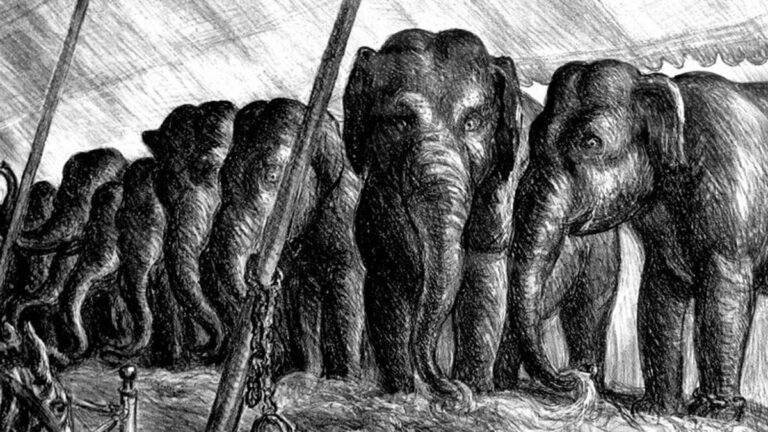The Midwest Museum exhibits “Under the Big Top.”
An exhibition devoted to circus as art could come at the venerable form of entertainment from many different angles. He could see the circus as a cultural phenomenon, an institution that embodied a particular era in American history. He could see the imagery surrounding the circus as a source of American folk art. Or it could consider how the circus environment can be a source of inspiration for artists.
“Under the Big Top: The Circus as Art in America,” an exhibit running through July 10 at the Midwest Museum of American Art, presents the circus from all three of these vantage points, and does so in an appropriately entertaining way.
The exhibition brings together more than 50 works by 35 different artists and includes a wide range of media, including photography, graphic arts, paintings, drawings, prints, sculpture and multimedia assemblages. The exhibition is presented in a whimsical tone, as visitors are first introduced to the subject in an original gallery adorned with posters, information panels and a replica of a vintage fortune-telling machine. From there, visitors pass under a colorful facsimile of a large stage at the heart of the show in the galleries beyond.
In these galleries, the exhibition supports the circus as a legitimate, rich inspiration for American art from the 20th and 21st centuries. Here, the circus as a cultural phenomenon is represented with a wealth of photographs from the heyday of the American circus in the first half of the 20th century. We see both the performances and the behind-the-scenes work, suggesting that the circus was both a popular pastime and a culture all its own.
However, this way of seeing the circus is not only presented through documentary images. Good artists also create their own interpretations of circus life, whether it's Diane Tessler's painting 'Funnel Cakes and Elephant Ears' or Adam Grant's thoughtful 'Harlequin & Model'.
The circus is also a place for whimsy and fun, and many of the acts in the show do their part to capture the spectacle and movement of the big top. Gregory Gorby's exuberantly colorful wooden sculptures are strangely entertaining, and paintings such as Kathy Ziedi's view from the perspective of a tightrope walker tap into the lively energy of the circus. Todd Hoover's photographs of posters and old toys connect the circus with children's play, and Cathy Pilling Morashi's kinetic sculpture of a carnival reinforces this connection.
Finally, the exhibit illustrates the influence of the circus on American graphic and folk arts. Advertising posters are endless examples of how the circus tried to translate the excitement of its performances into still images. The inclusion of vintage knock-down puppets from a carnival game show how the circus created its own image in a hands-on way, and objects such as a whiskey bottle in the shape of the iconic clown Emmett Kelly remind us how images of the circus permeated popular culture.
The exhibit includes works by famous artists with a circus theme, such as Leroy Neiman's “Ocelot,” an Alexander Calder painting depicting balloons, and a Charles Demuth depiction of acrobats. But it is in those places where the circus touches everyday American life—in folk art, in photographs, in the playful creations of lesser-known artists—that the exhibit makes its most compelling case that the circus has been a productive driver of American art for more than a century.
At the exhibition
• What: “Under the Big Top: The Circus as Art in America”
• Where: The Midwest Museum of American Art, 429 S. Main St., Elkhart
• When: Until July 10
• Hours: 10 am. to 4 p.m. Tuesday through Friday and 1 to 4 p.m. Saturday and Sunday
• Cost: $5-$4? free for members, ages 4 and under, and on Sundays
• For more information: Call 574-293-6660 or visit midwestmuseum.us

